Read Better with Craft and Readwise
Have you ever run across a book you know you’ve read but can’t recall much about it? Or, come across a passage in a book while you were reading that seemed important — something you knew you could use at some point in the future — but didn’t know where or how to save it so you could find it again?
Too often, I’ll pick up a book I’ve read just a few years back and feel a familiar sense of despair. I may have spent hours of study at the time, but it’s already become a blur. And how many hours of my life have I spent searching for something I read but can’t find?
For someone who invests a thousand hours a year reading, this kind of poor knowledge return always bothered me. I needed a simple system to make better use of the time I spent reading, but didn’t distract or pull me away from the flow of reading itself.
I’m pleased to share that two innovative apps — Craft and Readwise — have finally become that system for me. Both require a paid subscription, and one works only with Apple devices, so they aren’t for everyone. Yet, using these two apps has improved my reading retention, and perhaps more importantly, unlocked a way for me to consistently integrate what I read into a broader system of curated thought and wisdom.
What follows are the methods I employ in the reading system across three key activities:
(1) Capturing notes and quotes from my reading;
(2) Curating what I’ve captured inside my note-taking system; and
(3) Compounding the knowledge and insights I’ve gleaned with daily reviews and Zettelkasten-style linking.
There are a few caveats I’ll share before diving in. First, these workflows only apply to books I actively read with an alert mind and a notebook and pen nearby. The books I read for pleasure at night before bed don’t see much action in this system. Second, we’re in the early innings of a golden era of note-taking and reading technologies. The tools and techniques I’m using in early 2022 will continue to evolve as new capabilities and services emerge. And finally, I have no financial incentives or affiliations with Readwise, Craft or any other service or product mentioned in this post.
Phase I — Capturing
Capturing insights from my reading is the first phase of my system. I’ve learned that to remember and learn from what I read, I need to take notes. This part of the system is decidedly old school. If I’m reading an actual book, I almost always have a pen in my hand to mark passages or scribble notes in the margins. If I’m reading on Kindle, I highlight passages with my finger, but jot notes down on paper, usually in a Field Notes notebook. I’ve gotten in the habit of summarizing the main points of what I’ve just read to help forge a mental lock on the material. Often, in the process of putting something in my own words, I stumble upon some new insight I hadn’t comprehended at first blush. I also occasionally reflect on what I’m reading in my journal.
I use Readwise to import highlights and annotations from Kindle ebooks and online articles using the Pocket read-it-later app. Readwise is a subscription service that gathers and resurfaces highlights and annotations from books and periodicals. Readwise integrates with almost 20 reading sources. Kindle and Pocket highlights sync to Readwise automatically, so I don’t have to think about it while I read.
Capturing quotes from printed books is a Readwise superpower. The OCR engine inside the Readwise app is fantastic. Snap a picture of the page with your iPhone, pick the beginning and end of the highlight with your finger, tap the book (it remembers what you’re reading), and type in an optional page number. If you want to include a note with the highlight, tap the record button and add it with your voice. I batch my capture of highlights in chunks, and each takes about 20 seconds to process. When finished, all those highlights and notes are now magically part of Readwise.
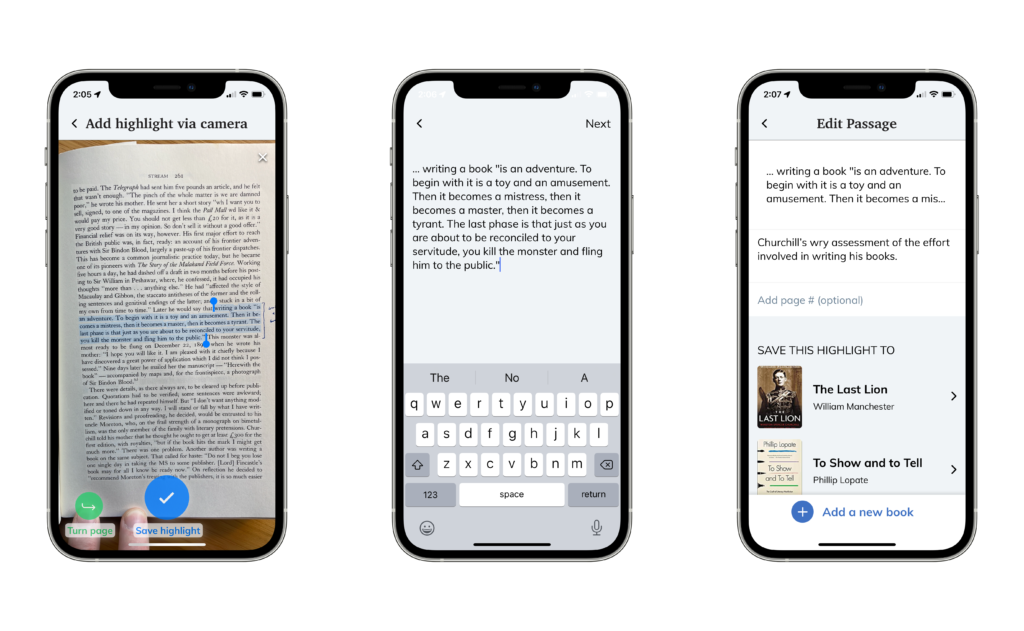
Besides books, I read a lot of online articles and blog posts, but I resist the urge to read these on the fly. Instead, I save them into Pocket and take time on the weekend to read through them all at once. I enjoy the reading experience on Pocket’s iPad app, and it’s a simple thing to add articles, even those behind paywalls. The free version of Pocket allows up to three highlights which is sufficient for most pieces. Highlights I make in Pocket flow automatically into Readwise.
Once a week, I archive the best Pocket articles into DevonThink for future reference. DevonThink is a tremendously powerful document storage app that I use to keep various personal and professional files, including the entire ship maintenance system for our trawler, MV Indiscretion. DevonThink can save Pocket articles as bookmarks, web archives, PDFs, Markdown, or plain text, and I can easily link to them from other apps (like Craft). I love having an established workflow for online articles. Nothing important I read falls through the cracks.
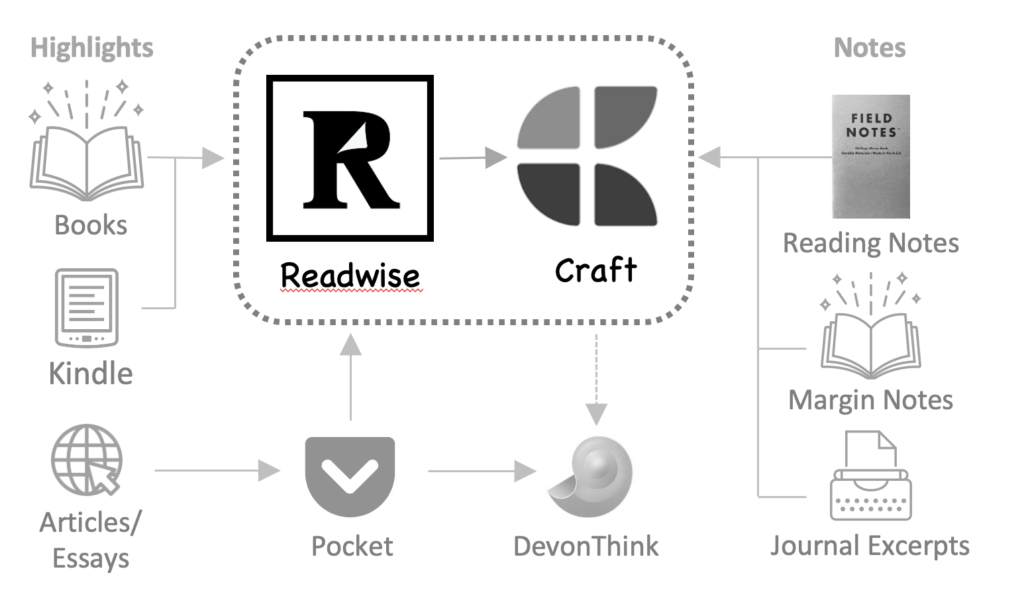
Phase II — Curating
The process shifts from Readwise to the Craft app in the curation phase. Craft is a markdown note-taking app with powerful linking capabilities that I adopted about a year ago for all my reading notes. You can read more about why I love Craft here.
When I finish a book or article, I create a new literature note in Craft that will ultimately include my notes, favorite highlights, and a personal review of what I’ve read. I keep a folder of reading templates in Craft to bring consistency and completeness to the process. I have templates for fiction, non-fiction, essays, and articles. For example, my fiction template has a section for the plot, characters, key themes, questions I had during my reading, favorite quotes, and my overall review of the book.
With the literature note now created in Craft, I copy in the highlights and annotations from Readwise with its custom markdown export function. Some note-taking apps like Roam or Obsidian can be integrated directly with Readwise, but this really isn’t necessary. I like having control over when I bring in my reading highlights, which isn’t any more complicated than a simple copy and paste.
Next, I copy in my handwritten notes from the margins of the book or Field Notes. I’ll flip through my journal in Day One and copy in relevant passages I wrote during my reading.
At this point in the process, the literature note is quite a jumble of highlights, journal entry excerpts, and note fragments. I sort through it all and try to bring forth order. Luckily, it’s simple to rearrange blocks of text in Craft, so I move things into proper sections and rewrite or expand on my notes. I summarize the main ideas of the book and any takeaways.
Finally, I try to think more broadly about how what I’ve read connects to other books or concepts in my reading system. This is where links come in.
Linking is a Craft mainstay. Type the @ symbol in a note, and you can create links to other notes within Craft. I add links at the block level from inside the book note to related permanent notes (or other book notes). Block-level links are truly a Craft superpower. Many Zettelkasten proponents insist on creating stand-along “atomic notes” to get the true benefit of a linked note system. I think Craft’s block-linking capabilities do a better job of preserving the continuity and context of the literature note, while producing excellent backlink references inside the destination note. Whether you use atomic notes or block-level links from inside your notes, this connection between notes serves as the backbone of a knowledge system that generates an ever-growing convergence of insights.
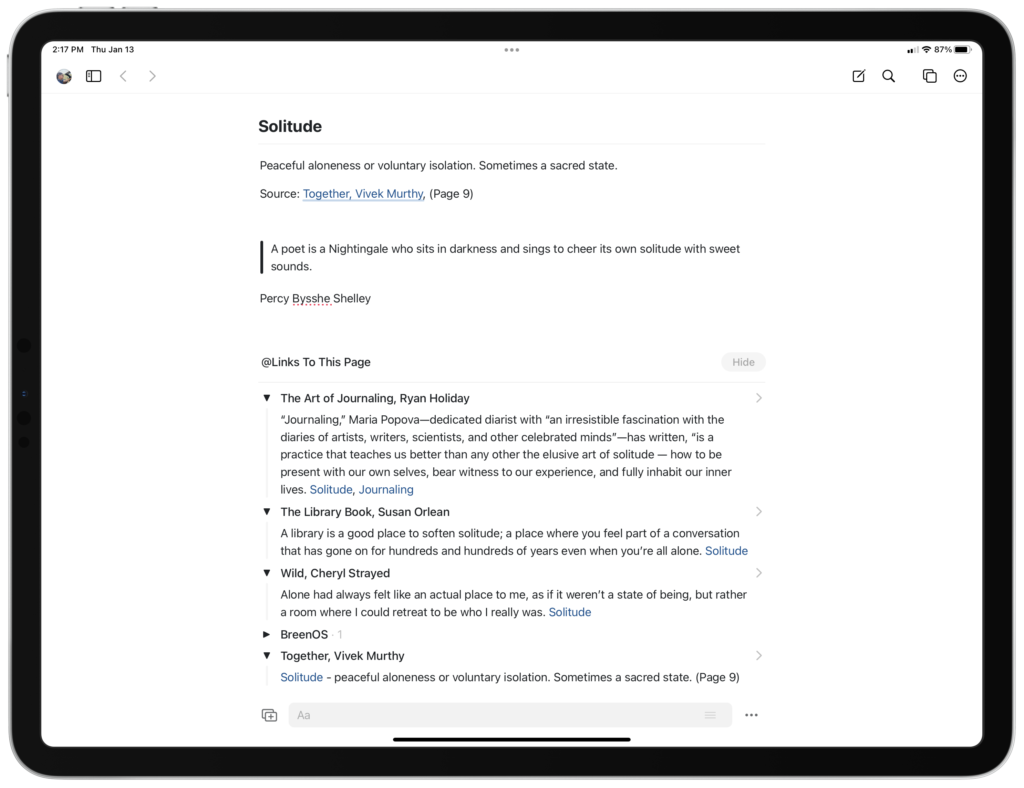
Phase III — Compounding
This brings me to my system’s final and most valuable phase: the compounding of knowledge and wisdom from my reading. I compare this phase to the compounding of interest on your retirement savings. The more you save, the faster it seems to grow, until eventually, the interest outpaces the principal. Midway through this past year, I reached that crossover point in Craft when the connections between books, world views, concepts, themes, and ideas began forming at an accelerating rate.
There are three primary methods I use to promote this knowledge compounding effect: (1) creating or updating permanent notes of ideas or concepts that run through my reading; (2) daily Readwise reviews; and (3) open-ended exploration of the system, which I affectionately call my Craft Time.
Permanent Notes
In my system, permanent notes are concepts, scientific principles, philosophical beliefs, genres, human conditions, cultural practices, etc. — thoughts or ideas that span across the books I read. An eclectic list of examples: Field Theory, Tides, Origins of Religion, Sobriety, Hindsight Bias, and Memoirs. I currently have 130 permanent notes in my system, yet I still frequently encounter new themes or concepts in my reading that don’t exist in Craft. If I think it’s worthwhile, I’ll add the link anyway, which creates a new note in Craft’s Inbox. Later, I’ll open the note and bring it to life as a proper permanent note. This almost always starts with a CMD-O search through my system for any related notes that might deserve a link.
Searching a well-populated Craft database of your reading notes and inner thoughts invites serendipity and wonder. The search results are near instantaneous and displayed in a sensible order — documents with the search term in the title first, blocks next — with a preview of each result.
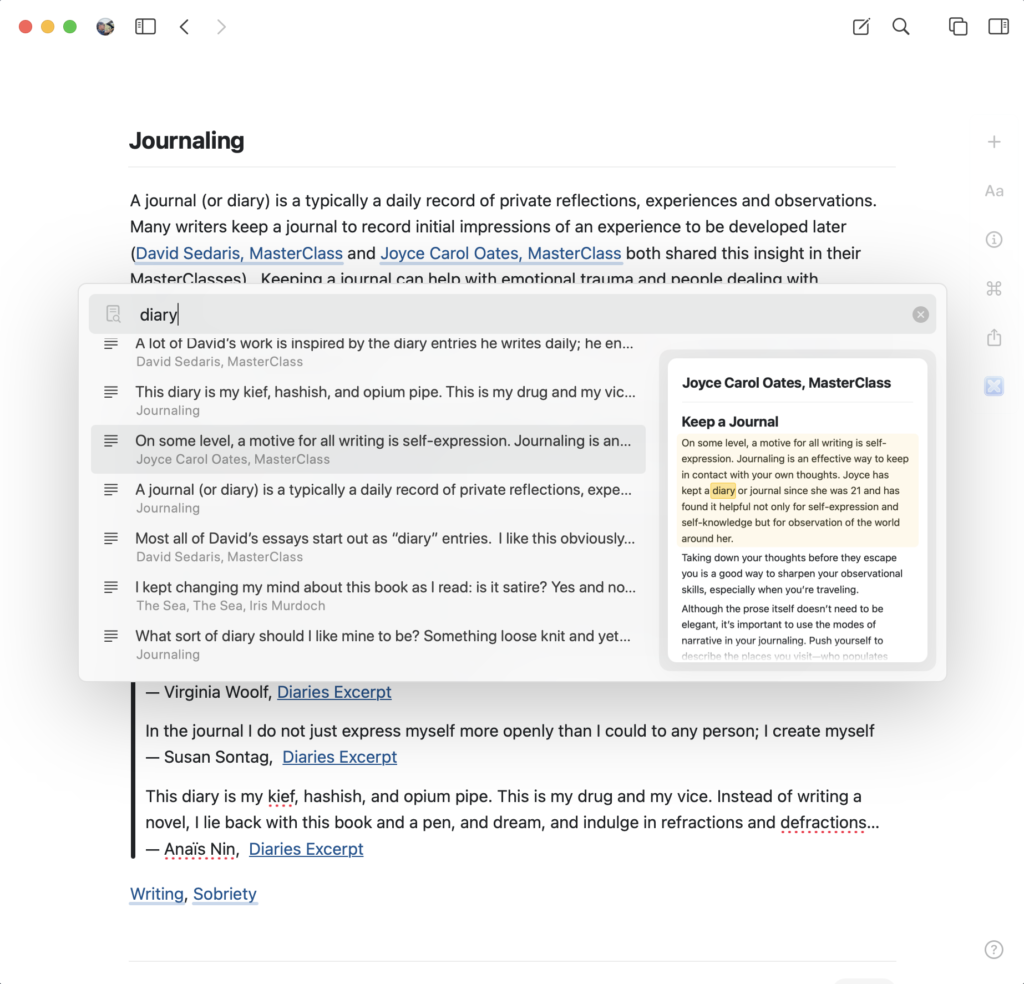
In the early days of using Craft, these searches were ho-hum. But now, after curating hundreds and hundreds of interconnected notes, searches frequently yield something unexpected, insightful. With a few keystrokes, I discover connections to similar ideas in other books I’ve read in the past; call it my personal Wikipedia, written in partnership with the authors I most admire, just for me. How else would I connect Cheryl Strayed’s appreciation of solitude while hiking the Pacific Coast Trail with Susan Orlean’s happy time in a crowded public library or Maria Popova’s sanctuary within the pages of her private diary?
I usually discover other books or notes that relate directly or indirectly, and I add the appropriate links to these newborn permanent notes. I almost always sigh to myself at this point. How many books have I read over the past three decades that touched on this theme that are now gone forever from my mind because I didn’t have Craft?
Finally, I’ll add the permanent note to my master index, known in PKM circles as as Map of Content. But rarely is this the end of the note’s evolution and growth. Once a note enters Craft — and I suspect also my subconscious — I find myself adding more and more references and links to related content in fits and starts over time.
Daily Readwise Reviews
One of the benefits of being a Readwise subscriber is the daily review of a random selection of your reading highlights. These arrive by email or inside the app itself and follow a pattern of spaced repetition to help you improve retention. You can set how many highlights you want to review each day and create themed reviews that pull from selected books or tags. I was an early adopter of the Kindle e-reader, so I’m able to revisit a veritable treasure trove of highlights I captured years and years ago.
These morning reviews provide an opportunity to think deeply about a handful of highlights from a population of more than a thousand I’ve captured. For each one, I ask myself a series of questions. Why does this highlight resonate with me? Does it support something else in my reading system? Could I write something of my own that stems from this quote?
These review sessions almost always lead me into Craft to edit a particular permanent note, add a new link from that day’s highlight, or record a new writing idea or topic (which I also keep in Craft). It’s a rare day that I don’t add or revise my reading notes after a Readwise review.
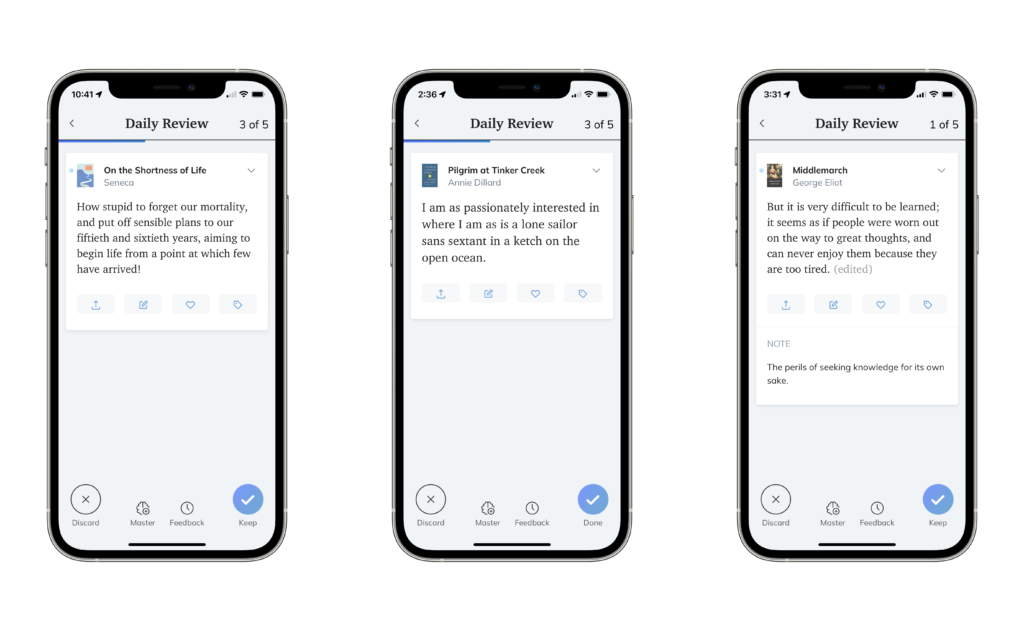
Craft Time
I’ll call out my third way of compounding knowledge as simply Craft Time. More and more, I feel drawn to explore and broaden my reading notes, almost like seeking the dopamine hit from social media apps like Facebook or Twitter. Yet, here, the content is uniquely tailored to me, and in a sense, constantly growing and changing as I add and connect notes and ideas. Instead of refreshing an endless Facebook feed, I am exploring pathways of thought that are at once familiar but also entirely novel to me.
In practice, this involves reviewing and adding links between meaningful passages of books and articles to appropriate themes; developing notes for new themes or ideas; and most recently, breaking apart and propagating notes that have grown too large. Sometimes, my Craft Time is simply open-ended discovery. Scanning the backlinks from my notes on Friendship, Regret, Mortality, Meaning of Life, or Time can transport me mentally — sometimes quite spiritually — to a place I would be hard-pressed to find another way.
I recently read Annie Dillard’s Pilgrim at Tinker Creek. I read this twenty years ago, and it was one of those books that had fallen into that blurry category of non-remembering. This second reading mesmerized me with its beautiful observations of the natural world set alongside a backdrop of religion and philosophy. Before long, I was comparing Dillard’s breathtaking assessment of the vastness of the universe with similar musings from Blaise Pascal and Neil deGrasse Tyson. It’s like this reading system of mine has unlocked something in my brain that now permits me — no, implores me — to step outside the single book and see patterns and themes across books, across genres of literature, across vast swaths of science and philosophy.
In Mortimer Adler’s How to Read a Book, he describes the most advanced and challenging reading level — Syntopical Reading — as reading many books on the same subject and studying the differences and similarities in themes, ideas, arguments, and styles. I can’t say I often live up to Mr. Adler’s standards, but I think this system in Craft approaches his syntopical ideal with its blossoming cross-reference links and aha! insights that emerge from my time with it.
Is It Worth It?
Cost will be an issue for anyone considering a reading system like this. Between Readwise and Craft, I’m shelling out $150 per year in subscription fees. That might seem like a hefty outlay for reading, given there are free or less expensive options. For example, Readwise offers Bookcision, a tool that allows you to download properly formatted Kindle highlights for free. Obsidian, a popular PKM app, offers a capable free tier and supports at least one free community plug-in to download Kindle highlights.
While I could cobble together a free solution, it’s worth it for me to pay for a seamless experience. For me, the benefits accrue in three ways:
- More focus, less distraction. Both Readwise and Craft offer an attractive, uncluttered design and user interface that promotes thinking over futzing with software settings. Focus is hard enough to come by these days, and I appreciate the calming interface these apps use in elevating my book highlights and notes. How do you put a price tag on sustained concentration?
- Nothing slips through the cracks. No matter what or how I read, Readwise captures my highlights without thinking about it. While Bookcision or an Obsidian plug-in might work fine for Kindle highlights, what about printed books? Or web articles? I could process these manually with an iPhone scanner, copy and paste them into the proper text file, and then return to my reading. But for me, that’s the whole point of having a reading system. I can focus on the text without the worrying distraction of how I’m going to act on what I’m reading.
- Higher return on investment. In the course of a year, I’ll read around 60 books and many hundreds of articles and essays. At typical adult reading speeds, this means I spend at least 1,000 hours each year reading. In addition, I spend about $1,000 a year on books and news subscriptions. Between time and money, my investment in reading is considerable. For me, spending a little on tools to ensure I get a great return on that investment is a no-brainer. At 15 cents per reading hour, I assure you that I am getting a good return on Readwise and Craft.
A Wish List
While I am pleased with this system, there are few things that I hope will improve in the future:
- Kobo Support in Readwise. I read about half my books on Kindle, but am very interested in switching to the Kobo e-reader to lessen my reliance on Amazon as a company, and enjoy a better reading experience when borrowing books through Libby. Readwise doesn’t yet provide a way to import reading highlights and notes from Kobo, so I’m staying put with Kindle until that functionality exists.
- Tighter Readwise and Craft Integration. I’m using a custom markdown export tool from Readwise to bring my highlights to Craft, but it requires the use of a web browser and text editor to make the transfer. having a built-in integration with Craft or a way to copy the highlights out of the Readwise app itself would be an improvement.
- A Better Solution for Reading Articles. Pocket works for my article reading, but there are some downsides. The free version limits you to just three highlights, and you’re not able to add any notes to what you’ve highlighted. Readwise has announced their own read-it-later app called Reader which I’m told will provide a better overall reading experience. I’ll be very curious to try this out when it’s eventually released.
Smarter Reading
I can’t help but feel both excited and wistful about the state of reading today. As a lifelong bookworm, I am thrilled that technologies have emerged to take reading retention and knowledge assimilation to new levels. I am now more inclined to tackle difficult books because I have a method to mine and refine their gems of wisdom.
But, part of me laments the fact that these technologies didn’t exist when I was younger. I cannot even begin to imagine the level of knowledge a system like this would yield after thirty years of continuous use. While I read mainly for self-improvement and entertainment, can you imagine the power of a reading system like this for a doctoral candidate writing a thesis? Or a writer collecting research for a book?
They say the best time to plant a tree was twenty years ago. The next best time is right now. There’s never been a better time to become smarter in how you read.
Questions about this reading system with Craft and Readwise? Leave me a note in the comment section below.